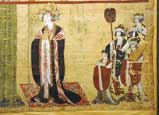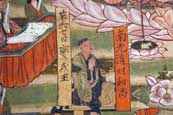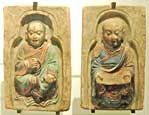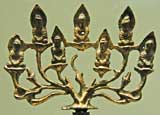The Mogao Caves at Dunhuang, in western Gansu Province at the edge of the desert, contained arguably the greatest repository of Silk Road materials to survive until modern times. For the most part the paintings and sculptures of the grottoes themselves are still in place. Grotto no. 17, which was discovered ca. 1900 by the local caretaker at the site, housed a vast array of manuscripts and paintings. The British explorer, Aurel Stein, had the good fortune to be the first westerner to obtain access to those materials in 1907, the result being that a substantial portion of the collection is now in London (and some in Delhi). Pelliot made it to Dunhuang the next year and was able to remove to Paris the largest part of the remaining cache, including some of the most important manuscripts and best paintings. The manuscripts are in the Bibliothèque nationale and the works of art and photographs are at the Guimet. The Guimet displays a few of the most spectacular silk banner paintings Pelliot acquired as well as some of the rare wood sculptures and other material; all of it has been described in published catalogues. Among the most noteworthy achievements of the Pelliot expedition was to produce an extensive set of photographs of the grottoes, which retain their value for the study of the murals in the caves. What was left at Mogao after Stein (who returned to remove more material) and Pelliot is now scattered in collections mainly in St. Petersburg, Beijing, and Tokyo. All of this material will eventually be accessible in electronic form thanks to the International Dunhuang Project, based at the British Library. As the IDP reports (as of April 2007), the French collections have been digitized, and work is underway to make them available as soon as possible.

|
Mandala of the bodhisattva Avalokiteshvara.
Dunhuang, Mogao grotto no. 17. T'ang pd., mid-8th c. CE. Painting on silk.
Pelliot expedition, 1906-1909. Inv. no.: MG 26466.
|




|
1000-armed, 1000-eyed Avalokiteshvara.
Dunhuang, Mogao grotto no. 17. N. Song pd., 981 (6th year of Taipingxingguo era). Painting on silk.
Pelliot expedition, 1906-1909. Inv. no.: MG 17639 (?).
|










|
Bodhisattva Kshitigharbha, the six ways of rebirth and the 10 kings. Dunhuang,
Dunhuang, Mogao grotto no. 17. N. Song pd., 981 (the eighth year of the Taipingkingguo era). Painting on silk.
Pelliot expedition 1906-1909. Inv. no.: MG 17662.
|

|
Banner.
Mogao grotto no. 17. Silk.
Pelliot expedition, 1906-1909. Unnumbered.
|

|
The bodhisattva Avalokiteshvara and Buddha Shakyamuni, diptych.
Dunhuang, Mogao Caves. T'ang pd., 7th-8th c. CE. Wood with traces of polychrome.
Pelliot expedition, 1906-1909. Inv. no.: EO 1110..
|

|
Two seated monks, part of a frieze.
Dunhuang, Mogao grottoes. End of 9th-beg. of 10th c. CE. Terracotta, polychrome.
Pelliot expedition, 1906-1909 (?). Inv. nos.: MA 6752, MG 18627. For two examples of what was apparently a larger set of such images, go to Delhi1 and Delhi2, which Stein removed to New Delhi.
|


|
Avalokiteshvara.
Dunhuang, Mogao grottoes. T'ang pd., 9th-10th c. CE. Wood.
Pelliot expedition, 1906-1909 (?). Inv. no.: EO 1117.
|

|
Avalokiteshvara.
Dunhuang, Mogao grottoes. T'ang pd., end of 9th-beg. of 10th c. CE. Wood with traces of polychrome.
Pelliot expedition, 1906-1909 (?). Inv. no.: EO 1118.
|

|
Standing Buddha.
Dunhuang, Mogao grottoes. T'ang pd., 1st half of 8th c. CE. Wood with traces of polychrome.
Pelliot expedition, 1906-1909 (?). Inv. no.: EO 1103.
|


|
Lokopala.
Dunhuang, Mogao grottoes. T'ang pd., end of 7th-beg. of 8th c. CE. Wood, polychrome, traces of gilt.
Pelliot expedition, 1906-1909 (?). Inv. no.: MG 15142. Cf. Jarrige et al., p. 33.
|

|
The seven buddhas of the past seated on a lotus.
Dunhuang, Mogao grottes. End of 6th-beg. of 7th c. CE. Gilded bronze.
Pelliot expedition, 1906-1909. Inv. no.: MG 15080.
|
























